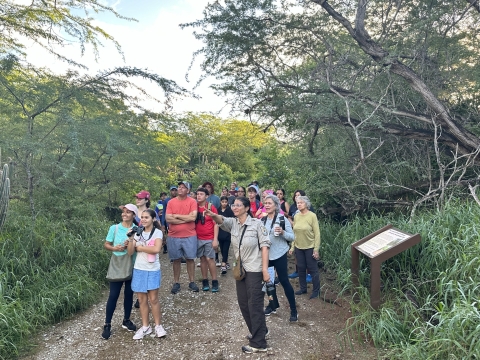Visit Us
Visiting the Cabo Rojo National Wildlife Refuge provides the opportunity to enjoy nature walks where you will be able to appreciate and learn about the unique flora and fauna of the area. This includes: endemic species, invasive species invasive species
An invasive species is any plant or animal that has spread or been introduced into a new area where they are, or could, cause harm to the environment, economy, or human, animal, or plant health. Their unwelcome presence can destroy ecosystems and cost millions of dollars.
Learn more about invasive species , endangered birds and plants, resident birds, and migratory birds. The trails at the refuge contain informational panels so you can learn about the different species whether you choose to schedule a guided tour or explore at your own pace.
At the Cabo Rojo NWR Salt Flats Unit we have three different hiking trails where you'll find mangrove forests (consisting of the four mangrove species present in Puerto Rico), subtropical dry forests, pink hypersaline lagoons, and more. We also have an Interpretive Center where we provide one-on-one information about the history of the salt flats and salt mining industry in Puerto Rico, its importance for the people of Cabo Rojo, biological importance of the area for birds, ecosystems present, directions, fun facts, and answers to all your questions.
At both units people can connect with nature and the cultural history of the area. Our goal is that every visitor leaves with a sense of connection, belongingness, and responsibility to protect these beautiful habitats and all organisms that inhabit them.
The Cabo Rojo National Wildlife Refuge is open Monday - Thursday from 8:00 am - 4:00 pm and Friday - Saturday from 7:30 am - 2:00 pm. The Salt Flats Unit and Interpretive Center are open on Fridays and Saturdays from 7:30 am - 2:00 pm.
Visit our Facebook page or call at 305-587-7856 for more information.
Location and Contact Information
- Cabo Rojo National Wildlife RefugeView DetailsC/O Carribean Islands Refuges Carr 301, Km 5.1, Bo Corozo Boqueron, PR 00622-0510
About Us
Cabo Rojo National Wildlife Refuge is one of nine refuges that encompass the Caribbean Islands National Wildlife Refuge Complex and where the headquarters are located. It was established for its indispensable value in “carrying out the national migratory bird management program”. The different ecosystems present provide habitat for migratory and resident birds as well as more than 78 threatened or endangered species!
What We Do
Our main objective is restoring and enhancing native wildlife and plants. We aim to protect our threatened and endangered species, and the Cabo Rojo Salt Flats (one of the most important shorebird habitats in the Caribbean). To achieve this, we don’t only carry out extensive research and projects but also fulfill our role as educators. We visit schools, program interpretive tours, host community events, and inform all visitors and residents about the importance of conservation. We are strong believers in the importance of educating. After all, knowledge is power, and an educated community is one that can carry out our mission for generations to come.
Our Species
Cabo Rojo NWR is a critical habitat for the endemic and endangered Yellow-shouldered Blackbird (Agelaius xanthomus) and Aristida chaseae grass species. There are other bird species present in this location like the Puerto Rican Tody, Adelaide’s Warbler, Caribbean Elaenia, Venezuelan Troupial, and more.
At the Cabo Rojo NWR Salt Flats Unit, you will find an array of seabirds and shorebirds. During nesting season, the Least Tern, Snowy Plover, and Wilson’s Plover utilize this area. The Cabo Rojo Salt Flats is the only locality island-wide where Snowy Plover nests have been recorded.
At least 245 plant species and 145 bird species have been identified on the refuge.
Get Involved
U.S. Fish and Wildlife Service's mission is to conserve, protect, and enhance animals, plants, and their habitats. This goal cannot be achieved without the help of others. If you are interested in becoming a key part of the conservation of our natural resources, you are in the right place! By getting involved you will have the opportunity to master new skills, bond with the community, make new friends, and most importantly, safeguard these species and their homes so they can have a future where they not only survive but also thrive.
Check our "Get Involved" section for information about volunteering, internships, research opportunities, photography permits, commercial permits, and more.





















